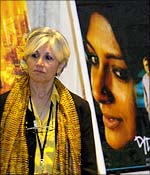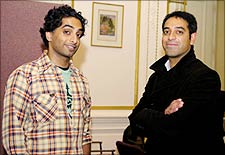|
|
| Help | |
| You are here: Rediff Home » India » Movies » Hollywood News |
|
 Aroon Shivdasani, executive director of the Indo-American Arts Council. | ||
| |||||||||||||||||||||||
|
| |||||||||||||||||||||||
Mira Nair may currently be away at the London [Images] Film Festival, but will surely be in New York to attend the opening of the Indo-American Arts Council Film Festival on November 1.
The gala opening the festival features a screening of her film, The Namesake [Images], and a post-screening discussion featuring Nair and novelist Salman Rushdie.
Also on their way to New York are Shabana Azmi [Images], whose Umrao Jaan [Images] will be screened at the festival, and Nandita Das, star of festival entry Podokkhep (Footsteps).
For now, on Thursday October 26, nearly two dozen artists and filmmakers -- mostly products of major American universities -- joined Aroon Shivdasani, the executive director of IAAC, in New York to discuss their films, and the event.
Running from November 1 to 5, the festival will screen over 60 feature films, including mainstream fare like the Aishwarya [Images] Rai-Abhishek Bachchan film Umrao Jaan, which will screen here on November 2, a day before its worldwide release. The entries include feature-length documentaries and shorter films, all of varying topics.
 The five-day event focuses on films from South Asia and the Indian Diaspora. However, several of the films -- including Two Men in Shoulder Stand, a 20-minute look at anti-AIDS and communal discord -- are directed by people of non-South Asian origin.
The five-day event focuses on films from South Asia and the Indian Diaspora. However, several of the films -- including Two Men in Shoulder Stand, a 20-minute look at anti-AIDS and communal discord -- are directed by people of non-South Asian origin. Paul Knox, director of the film featuring Manu Narayan (who enjoyed a Broadway hit with Bombay Dreams two years ago), says it is about a couple that is sero-discordant (one HIV-positive, the other not); one Muslim, the other Hindu. Narayan (left) dropped by at the press meet to greet the participants.
Cornell University alumnus Director Suman Ghosh makes a debut with the Bengali Podokkhep, a film about a young girl and an old man, played by Soumitra Chatterjee, veteran hero of many a Satyajit Ray film.
Preeti Mankar, a film graduate from New York University, went home to Mumbai, to make a 27-minute long documentary, I Am Bombay.
Using six-degrees-of-separation, she says her film moves from one character to the next, glimpsing the city through the contrasting perspectives and lifestyles of a slum dweller and a film star, an upper class housewife and an artist, a street vendor and a dance choreographer.
 Like Mankar, Pakistan's Afia Serena Nathaniel (right) also studied in New York, and her Toba Tek Singh, based on a short story by the distinguished Saadat Hasan Manto, grew out of her thesis work at Columbia University.
Like Mankar, Pakistan's Afia Serena Nathaniel (right) also studied in New York, and her Toba Tek Singh, based on a short story by the distinguished Saadat Hasan Manto, grew out of her thesis work at Columbia University."Ordinary people have extraordinary stories to tell," she says. Her film revolves around a fictional situation where governments of India and Pakistan decide to exchange lunatics from their madhouses the same way some civilians were exchanged.
Deep Katdare and Pooja Kumar star in Rehana Mirza's Hiding Divya, about a grandmother (Madhur Jaffrey) facing severe mental illness, her estranged daughter (Pooja Kumar) and a granddaughter bonding with the grandmother.
Raghu Jeganathan's documentary Men of Burden focuses on a tiny segment of workers in Pondicherry, who like millions of Indians, are not benefiting from the prosperity born out of globalisation. He focuses on cycle-rickshaw drivers.
"After every screening, we plan to have a discussion," explains Shivdasani. "The festival offers very good opportunities for newer and older filmmakers to meet. The audiences will also have opportunities to meet with the directors, writers, producers and actors."
"Not only do we showcase films by South Asians and of South Asian origin," went on IAAC Film Festival Director Pooja Kohli Taneja, "but we also offer tremendous support for their work."
Salman Rushdie, who is co-chair of this year's gala, along with his wife model and actress Padma Lakshmi [Images], continues to be one of the biggest supporters of IAAC and its many cultural activities.
"The IAAC is an important, thriving initiative," he says.
Photographs: Paresh Gandhi
|
|
| © 2008 Rediff.com India Limited. All Rights Reserved. Disclaimer | Feedback |